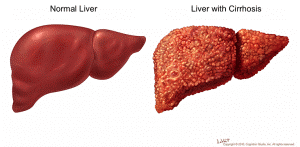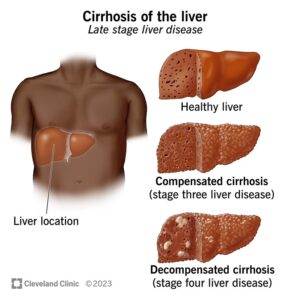What exactly is Liver Cirrhosis?
Dr. Claire Arcidiacono, ND
In my experience as a Naturopath cirrhosis of the liver is one of the most confusing disorders that people can experience. What exactly even is cirrhosis? What cause’s it? What are the symptoms one might experience? What are the possible complications? And lastly what steps can be taken to reduce the risk factors for cirrhosis and improve liver health? It’s a lot to talk about so I will be breaking this into 2 parts. This is so it doesn’t become too overwhelming.
Basically cirrhosis is severe scarring of the liver. When the cells of the liver are damaged for any reason the cells will try to repair themselves. Unfortunately in this process scar tissue forms. This scaring, or cirrhosis makes it hard for the liver to do its job well. (1) In a way it’s like when you get a scar on your skin after an injury. The skin is never quite the same. Well in this case the scar tissue that replaces the healthy liver tissue doesn’t have the same properties or abilities as a healthy liver. Thus as the cirrhosis, or scar tissue progresses (or takes over more of the liver) there is less and less healthy liver to do its job and thus symptoms get worse. Please take a look at the attached picture. (2)

So just what can cause this scarring of the liver, or cirrhosis? Well as I said anything that damages the liver can lead to cirrhosis. As I said in my blog on fatty liver have NAFLD is a possible cause of cirrhosis. Please read my blog for suggestions to help reduce the risk of fatty liver! Having a history of hepatitis, either viral or autoimmune can lead to cirrhosis. Other chronic conditions that can lead to cirrhosis include hemochromatosis, cystic fibrosis, Alpha-1 antitrypsin deficiency, glycogen storage disease and Alagille syndrome. Wilson’s disease can also lead to cirrhosis. Certain diseases that affect our gallbladder can also lead to cirrhosis. Certain infections other than hepatitis can also lead to cirrhosis. These include syphilis. Lastly certain medications can increase your risk of developing cirrhosis. If you have any concerns about your medications it is always important to talk to your doctor. (1)
Cirrhosis is considered to be a progressive condition that worsens over time. As the disease progresses the symptoms will become worse. The reason for this is because over time more and more of the liver is replaced with that scar tissue thus as I said there is less of the healthy liver available to do its job. Please see the attached picture. (3)

As for lab work I will refer you to my blog on this topic. If you have any questions feel free to reach out to me and I will be happy to review your blood work! Now just what are they signs of liver cirrhosis? Well you may notice you feel fatigue. You may notice the development of spider veins as well as bruising and easy bleeding. You may start to feel nausea which can reduce appetite and even lead to weight loss. Your skin may become itchy. There may be a yellow discoloration of the skin and eyes (this is jaundice) and redness in the palms of the ands. There may be edema/ swelling in the legs, feet or ankles. There may be ascites (fluid accumulation in the abdomen). Changes in the nails can include becoming a pale color and clubbing or roundness to the nail. (1) Later stages may include confusion, disorientation and even mood changes. There may be changes to your urine and feces in color and there may even be blood in your stool. There may also be blood in your vomit. You may develop motor dysfunctions such as tremors. You may notice that you have difficulty with digesting fats. Women may experience menstrual cycle disruptions and men may experience enlarged breast tissue and shrunken testes. Lastly in the long run there may be low urine output and even shortness of breath. (3)
In our next blog we will talk about complications of cirrhosis and even review some things that can help with overall liver health. These nutrients will include Milk Thistle, NAC and even surprisingly Turmeric!
Sources:
- https://www.mayoclinic.org/diseases-conditions/cirrhosis/symptoms-causes/syc-20351487
- https://www.sgihealth.com/patients/digestive-health-library/cirrhosis/
- https://my.clevelandclinic.org/health/diseases/15572-cirrhosis-of-the-liver









